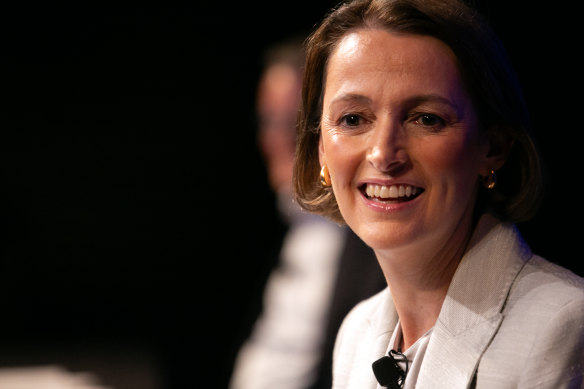Opinion
How Telstra’s first female chief is transforming the telco giant
Elizabeth Knight
Business columnistNothing champions the push for more women to join the ranks of big-end-of-town chief executives than success. As such, Telstra’s Vicki Brady has done plenty to further the cause.
The 53-year-old and the NSW hamlet of Holbrook’s biggest export is transforming our telco giant by deploying pragmatism, abandoning hubris, and adding a big dollop of financial realism and a focus on investors.

Telstra boss Vicki Brady recognised that the company needed to focus on what it did best.
Telstra’s full-year earnings result produced a fall in headline profits of 13 per cent, however it’s a number that disguises some good financial performances in two of its most important businesses – infrastructure and mobiles. The underlying earnings were up 4 per cent.
But more importantly, the write-downs that drove down the headline result arose from Brady’s recognition that Telstra needed to focus on what it did best, and eschew some of the more fashionable and glamorous high-tech services that for years Telstra has been gagging to sell to its big business and government customers.
For years and under the previous two chief executives Telstra pushed its bona fides as a “technology company” rather than a telecommunications company.
(It may have been the right strategy at the time, but the world has moved on.)
It has become abundantly clear to everyone that Telstra’s real advantage is its network – which is the business of connecting.
As such, it went off on a flurry to provide all kinds of services that could hang off its networks which it could sell to big business. These were mainly housed in Telstra’s Enterprise division.
Part of the previous long-term plan was to sell off or sell down its infrastructure business that actually housed some of these connectivity assets.
Telstra sold a minority stake in the cell towers but under Brady the company made the pretty radical decision to hold on to massive infrastructure business. In doing so, she and Michael Ackland, who rides shotgun as chief financial officer, resisted a $15 billion financial sugar hit.
At the time the decision seemed “crazy brave”.
This was a particularly gutsy call one year into the role because many Telstra shareholders had been salivating over the return of capital they were set to receive when this cash hit the company’s coffers.
A year down the track, it has become abundantly clear to everyone that Telstra’s real advantage is its network – which is the business of connecting. Specialist companies that can provide services that use the network abound – and they are either better than Telstra at providing these bells and whistles or can at least compete away Telstra’s profit in this area.
This explains why a few months back, Brady drew a line in the sand on the Enterprise business or, more particularly, the part of this division that sold these value-added services – the Network Application Services.
It simply couldn’t compete with the specialist services from the world’s big tech companies that dominate the landscape and devote billions of technology dollars to cutting-edge products and services.
Two-thirds of Network Applications services and products have been removed from the shelf.
The capital expenditure is now focused on improving the mobile network and building inter-capital city fibre. Telstra has a natural advantage in this space and the growth of artificial intelligence only enhances the need for these networks.
Already, Telstra has signed up Microsoft to be its first client.
In playing to Telstra’s strengths Brady has also been spending capital on its mobile network, where it is the dominant player.
In the 2024 result, Telstra managed to post a healthy increase in subscriber numbers and some improvement in revenue per subscriber.
The raft of increases to prices for mobile plans that have been announced, have been carefully calibrated to cater to differing levels of the cost of living pain that Australians are experiencing.
The cohort that can best absorb higher mobile prices will experience higher bills. For those struggling, some plans won’t become more expensive and others won’t rise above the rate of inflation. It will be more nuanced than Telstra’s previous pricing strategy of all plans moving in tandem with the consumer price index.
The share price reacted positively to the profit, in part because dividends rose 6 per cent and Telstra reaffirmed its guidance for the 2025 financial year profit.
After only two years in the job, Brady has managed to reset Telstra’s foundations, play to its strengths and more importantly recognise its limitations.
Read more:
The Business Briefing newsletter delivers major stories, exclusive coverage and expert opinion. Sign up to get it every weekday morning.